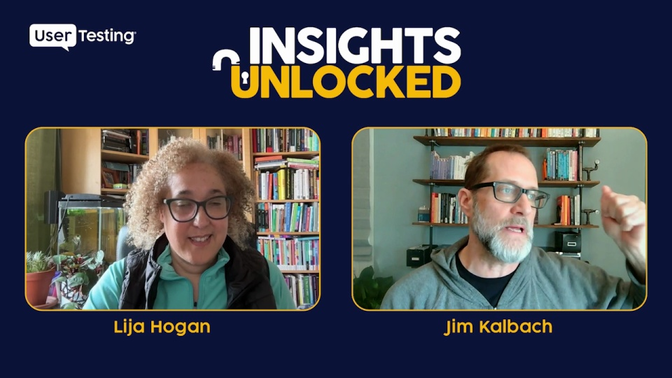
Episode 170 | May 12, 2025
Leverage the Jobs To Be Done framework to drive growth
Discover how Jim Kalbach uses Jobs to Be Done to align UX and business goals, drive growth, and leverage AI for smarter, customer-centric research.
Why Jobs To Be Done (JTBD) is the key to aligning UX and business growth
What if your UX strategy could do more than improve usability—what if it could drive real business growth?
That’s exactly what Jim Kalbach, Chief Evangelist at Mural, breaks down in this episode of Insights Unlocked in his conversation with UserTesting’s Lija Hogan. From experience mapping to leveraging artificial intelligence in research, Jim shares how the Jobs to Be Done (JTBD) framework offers a path to deeper customer centricity—and stronger business results.
Making UX a revenue driver, not a cost center
UX and design teams often find themselves fighting for resources or struggling to “earn a seat at the table.” Why? Because UX is often framed as a cost-saving tool, rather than a growth enabler. Jim believes it’s time to flip that script.
"If I were to go back and redo my UX career, I would use the word growth like punctuation," Jim said.
In traditional business environments, customer experience strategies are often measured by how much friction they remove or how they reduce call center volume. That’s valuable—but it positions UX as a cost-cutter, not a revenue generator. By contrast, JTBD reframes user experience as a catalyst for product market fit, customer loyalty, and adoption.

Understanding the jobs to be done framework
The Jobs to Be Done framework isn’t just a method—it’s a mindset. It’s about uncovering what customers are really trying to achieve, independent of the product itself.
"The job is not using your product,” Jim said. “The job is a goal someone has, a behavior they want to complete—regardless of your solution."
This distinction is crucial. When teams start with the customer’s desired outcome rather than the company’s offering, they open up space for innovation. UX research becomes a strategic tool for identifying unmet needs, enabling organizations to build better solutions and drive true product market fit.
From boardroom theory to everyday practice
JTBD may have originated in business strategy circles—with figures like Clayton Christensen and Tony Ulwick—but Kalbach has spent his career bringing it into the hands of everyday UX practitioners and product designers.
Rather than treating JTBD as a rigid framework reserved for consultants and executives, Jim encourages teams to use it in whatever way fits their process.
"I want to position jobs to be done as something anyone can use—in part or in whole. It's a mindset that literally everyone can tap into," he said.
This democratized approach to JTBD makes it an ideal tool for cross-functional teams that need to align around customer behavior.
ON-DEMAND WEBINAR
Continuous discovery: transform your product development process
How UX teams can gain stakeholder buy-in
A recurring theme in UX leadership is the challenge of getting buy-in from executives. Jim offers two practical tactics for building that support:
- Find a high-level champion: Identify a stakeholder who understands the JTBD mindset and can open doors for your work.
- Show the business impact: Use case studies and proof points to demonstrate how your research drives outcomes that matter—especially growth.
Crucially, Jim emphasizes the importance of empathy—not just for users, but for colleagues in marketing, sales, and product.
"Point your empathy maps back at your business stakeholders. Understand their motivations,” Jim said. “Apply design thinking to them, too."
By adopting a business-aligned UX strategy, designers can reposition themselves as growth partners rather than tactical executors.
Leveraging AI to power up research
The conversation also explores how artificial intelligence is changing the way we work in UX research. Jim’s take? AI is not here to replace researchers—it’s here to amplify them.
"Use AI to power up your human abilities. It's not about handing off a task completely—it's about making you smarter and faster," he said.
In the JTBD context, AI tools can help generate hypothesis-driven job maps and success criteria early in the research process. This allows teams to enter field research with a working model in hand—leading to more focused conversations and faster validation.
AI can also help in industries or domains where the researcher has limited subject matter expertise. By generating an initial framework, AI gives researchers a head start—especially useful in B2B or technical fields.
ON-DEMAND WEBINAR
The ROI of human insight: prove your value to upper management
Using JTBD to unlock growth opportunities
Jobs to Be Done isn’t just about improving product usability—it’s a tool for discovering untapped market opportunities. Jim sees JTBD as a way to uncover the “pull factors” that drive adoption and loyalty.
"People pull solutions into their lives that get a job done better than what they have now,” he said. “JTBD helps predict what those pull factors are."
When teams frame their product development around unmet needs and success criteria, they naturally prioritize the ideas with the most potential for market traction. This is a far more reliable growth strategy than pushing a solution and hoping customers will adopt it.
As Jim puts it, “Don’t solve growth at the point of sales and marketing—solve it at the point of unmet need.”
JTBD in action: What it looks like
- Instead of asking “How do we get users to adopt this new feature?” ask “What problem is the customer trying to solve, and how well does this feature help them do that?”
- Replace internal prioritization debates with JTBD research that highlights which jobs are most underserved—and most valuable to solve.
- Use job maps and success criteria to guide product roadmaps, ensuring alignment across UX, product, and engineering teams.
The future of UX is collaborative and customer-centric
As customer expectations evolve, Jim believes UX teams have a bigger role to play in shaping entire organizations. But it will require a shift in mindset—from specialists working in silos to facilitators of shared understanding.
He suggests that experience mapping tools like journey maps and service blueprints should be treated less as deliverables and more as collaboration catalysts.
"The power of a journey map is not in the artifact—it’s in the conversation it creates and the alignment it enables," he said.
Looking ahead, Jim envisions a future where UX isn’t confined to a single team. Instead, it becomes a shared responsibility across disciplines.
"UX filled a gap in organizations that shouldn't have existed,” Jim said. “If everyone truly focused on customer value, we wouldn’t need to advocate so hard for user needs."
Start with the human
As AI reshapes our tools and workflows, and business pressures mount, it’s more important than ever to ground our work in human insight. For Jim, the heart of innovation still comes back to the customer.
“If we want to be truly customer-centric, we can’t stop talking to customers,” he said. “AI can make us smarter, faster, better—but it can’t replace human connection.”
Resources and links
- Connect with Jim Kalback on LinkedIn
- Jim’s JTBD Playbook and Mapping Experiences books
- Mural
- Connect with Lija Hogan on LinkedIn
- Podcast: How women’s health app Clue uses Jobs to Be Done for product success
- Podcast: Creating a framework for customer listening with Dan Storms from CookUnity









